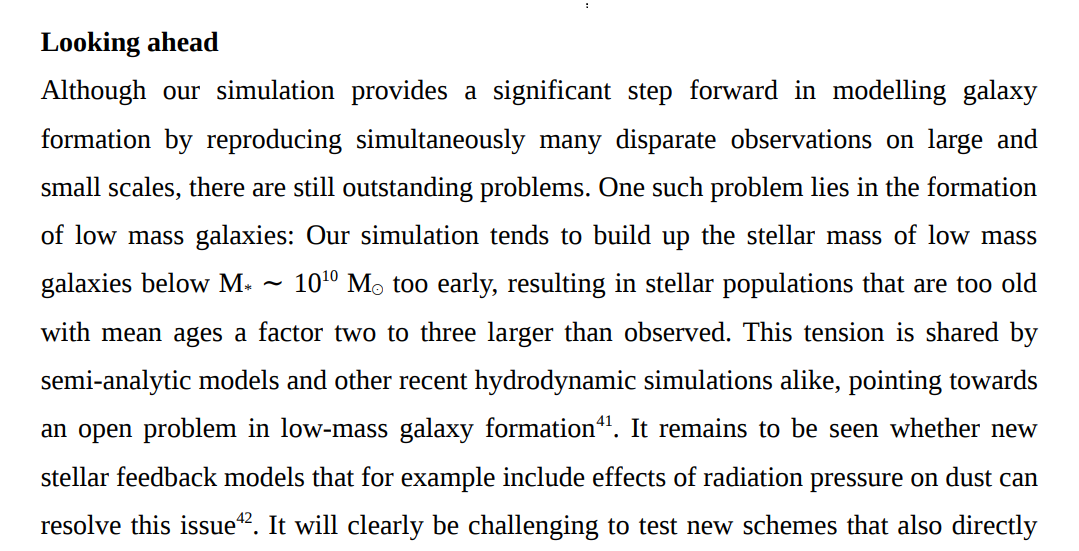Hello, I'm analyzing metallicity of subhalos in Illustris. Can you tell me what is the total mass of subhalos where metallicity becomes unreliable because of early star formation problem? I'm aware of the mass resolution and ways that small resolution of dwarf galaxies can make results unreliable, but I'm guessing that the mass cut off based on the reliability of metallicity is higher.
Thank you so much in advance.
Dylan Nelson
26 Oct '18
Hi Neda,
I'm not entirely sure what you mean by 'early star formation problem', can you elaborate?
Our canonical mass limit (due to resolution) is M* > 10^9 Msun, and I generally recommend this.
Neda Stojkovic
26 Oct '18
Hello :)
I read in the paper "Properties of galaxies reproduced by a hydrodynamic simulation" that simulation tends to build up stellar mass of low mass galaxies too early, so the star populations tend to be too old. I'm wondering what impact it has on metallicity of those galaxies and if it would be reliable to use gas-phase metallicities of galaxies with stellar mass above 10^7 Msun.
Dylan Nelson
26 Oct '18
Hi Neda,
A stellar mass of 10^7 is only ten star particles, and we would never advocate to consider this a robust or resolved regime of the simulation. As I mentioned above, 1000 star particles is a more realistic limit. Of course you can look at the gas-phase metallicities of these objects, but with this caveat in mind. As you can tell, Illustris does not really have the resolution to study such small dwarfs.
The statement you reference is, unfortunately, incorrect. It is based on an erroneous comparison to the observational data which was not appreciated at the time - the particular issue being light versus mass weighted stellar ages. The correct comparison with the data shows only a mild tension, e.g. around the 1 sigma level. Unfortunately I don't have a reference for this, but you can do this comparison yourself if it is important - the canonical observational data here is Gallazzi et al. (2005) from SDSS.
Hello, I'm analyzing metallicity of subhalos in Illustris. Can you tell me what is the total mass of subhalos where metallicity becomes unreliable because of early star formation problem? I'm aware of the mass resolution and ways that small resolution of dwarf galaxies can make results unreliable, but I'm guessing that the mass cut off based on the reliability of metallicity is higher. Thank you so much in advance.
Hi Neda,
I'm not entirely sure what you mean by 'early star formation problem', can you elaborate?
Our canonical mass limit (due to resolution) is
M* > 10^9 Msun, and I generally recommend this.Hello :) I read in the paper "Properties of galaxies reproduced by a hydrodynamic simulation" that simulation tends to build up stellar mass of low mass galaxies too early, so the star populations tend to be too old. I'm wondering what impact it has on metallicity of those galaxies and if it would be reliable to use gas-phase metallicities of galaxies with stellar mass above 10^7 Msun.
Hi Neda,
A stellar mass of 10^7 is only ten star particles, and we would never advocate to consider this a robust or resolved regime of the simulation. As I mentioned above, 1000 star particles is a more realistic limit. Of course you can look at the gas-phase metallicities of these objects, but with this caveat in mind. As you can tell, Illustris does not really have the resolution to study such small dwarfs.
The statement you reference is, unfortunately, incorrect. It is based on an erroneous comparison to the observational data which was not appreciated at the time - the particular issue being light versus mass weighted stellar ages. The correct comparison with the data shows only a mild tension, e.g. around the 1 sigma level. Unfortunately I don't have a reference for this, but you can do this comparison yourself if it is important - the canonical observational data here is Gallazzi et al. (2005) from SDSS.
Thank you very much for information.